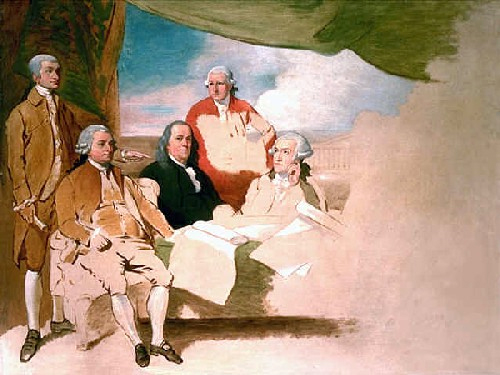 The Treaty of Paris was a formal agreement between America and Great Britain, signed on September 3, 1783. The signed agreement recognized American independence, established borders for the new nation, and formally ended the Revolutionary War. Articles of the treaty were being formed as early as 1782, and the Treaty of Paris was finally ratified by the Continental Congress in 1784. The treaty contained ten articles, or key points, and the preface declares the intention of both America and Great Britain to forget all past differences and misunderstandings.
The Treaty of Paris was a formal agreement between America and Great Britain, signed on September 3, 1783. The signed agreement recognized American independence, established borders for the new nation, and formally ended the Revolutionary War. Articles of the treaty were being formed as early as 1782, and the Treaty of Paris was finally ratified by the Continental Congress in 1784. The treaty contained ten articles, or key points, and the preface declares the intention of both America and Great Britain to forget all past differences and misunderstandings.
Preparing for Peace
Following the British defeat at Yorktown, peace talks commenced in Paris in April, 1782. The intent of the peace commissioners was to define and write an agreement or treaty, in which both parties could agree. This formal documentation seemed necessary, in order to decrease the risk of further disputes taking place in the future over land or issues of control.
Before the Treaty of Paris was written, preliminary Articles of Peace were formed. In 1782, Great Britain approached Benjamin Franklin with an informal peace agreement, which would have provided the thirteen states with a certain level of sovereignty within the British Empire. Franklin declined, insisting on the British recognizing American independence, and also wanting a peace treaty formed for France, the states’ ally during the Revolutionary War. Franklin did agree to proceed with further negotiations, for a more formal end to the war.
American peace commissioners John Jay and John Adams joined Franklin in Paris, and formal negotiations with Great Britain began on September 27, 1782. After two long months of difficult bargaining, the Articles of Peace were written, which would later become the foundation for the Treaty of Paris.
Summary of the Ten Articles
 The ten articles of the Treaty of Paris defined the agreement of peace between America and Great Britain. It was a most important document in history, because it was a formal declaration of peace, ending the Revolutionary War, and ending the struggle for America’s freedom from the British. The treaty consisted of ten important articles, each of which is very detailed, in order to prevent any ambiguity in the years following the signing.
The ten articles of the Treaty of Paris defined the agreement of peace between America and Great Britain. It was a most important document in history, because it was a formal declaration of peace, ending the Revolutionary War, and ending the struggle for America’s freedom from the British. The treaty consisted of ten important articles, each of which is very detailed, in order to prevent any ambiguity in the years following the signing.
The ten articles began with the acknowledgment of the United States as free, independent, and sovereign states, with the British relinquishing all claims. In the second article, boundaries are defined. The United States boundaries were considered generous, extending to the Mississippi River to the west, but in turn, Great Britain retained Canada. Article three states that America is guaranteed access to the Newfoundland fisheries.
Articles four through six, and nine address property and restitution of estates following the War. American Congress would recommend providing restitution of all estates and properties which were taken during the war. Both America and Great Britain would recognize their own contracted debts to be paid to creditors, and the United States would prevent future confiscations of property. Article seven guaranteed releasing any prisoners of war on either side. Article eight grants perpetual access of the Mississippi River to the United States and Great Britain. The final article indicated that ratification of the treaty was to occur within six months of signing.
Aftermath
With autonomy from Great Britain, some of the former protections such as Mediterranean Sea protection from pirates was withdrawn from the British. Individual states continued to ignore recommendations to return confiscated British property, and there were many disputes over boundaries. Native Americans were completely ignored when forming the Treaty, and boundaries which were set, were often ignored.
America’s ability to bargain on these issues was strengthened by the creation of the new United States Constitution in 1787. The Treaty of Paris was a starting point for future agreements, and a few disagreements. It was significant in history most notably, for formally acknowledging United States independence, and the end to a long war for freedom. The only article in the Treaty of Paris which still remains is article one.